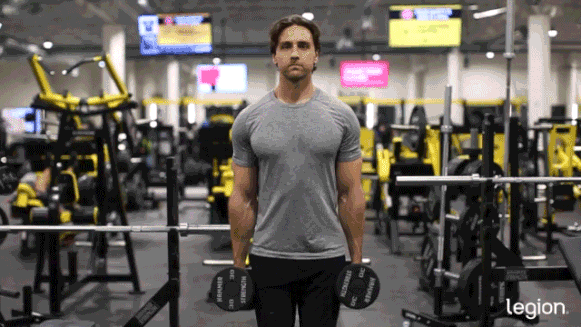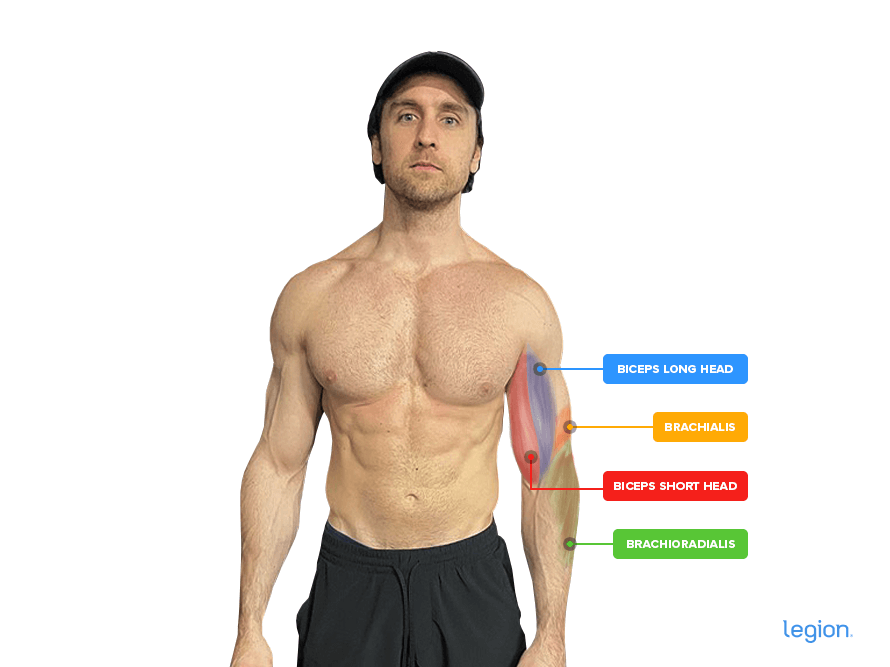The dumbbell hammer curl is a top-tier arm exercise.
While it trains the biceps to a high degree, it also emphasizes the brachialis and brachioradialis, two smaller muscles that significantly add to your overall arm size.
In this expert guide, you’ll learn how to do the hammer curl with proper form, why hammer curls are so beneficial, the muscles worked by the hammer curl, common hammer curl mistakes, the best hammer curl alternatives and variations, and more.
How to Do The Hammer Curl with Proper Form
To master hammer curl form, split the exercise into three parts: set up, curl, and descend.

1. Set up
Stand up straight with your feet shoulder-width apart. Hold a dumbbell in each hand with your arms at your sides and your palms facing your thighs.
2. Curl
Without twisting your wrist, bend your elbow and curl your right hand upward until the dumbbell is in front of your right shoulder. Allow your elbow to move forward slightly as the dumbbell rises.
3. Descend
Lower the dumbbell and return to the starting position. Don’t let the weight fall back to the starting position or try to straighten your arm slowly. The entire “descent” should be controlled but only take about a second.
Once your right hand is back at your side, repeat the pattern with your left hand (to complete one full rep).
Benefits of Hammer Curls
1. They maximize biceps growth.
Research shows that combining compound pulling exercises involving the biceps with biceps isolation exercises like the hammer curl maximizes biceps growth.
Doing so allows you to train your biceps at different angles and through varying ranges of motion, which produces more balanced and complete growth than only using compound exercises. It also ensures you train your “bis” with enough volume (sets) to stimulate growth without other muscles becoming a limiting factor.
2. They train your biceps unilaterally.
The dumbbell hammer curl is a unilateral exercise, which means it trains each side of your body independently.
Unilateral exercises are advantageous because they enable you to lift more total weight than you can with some bilateral exercises (exercises that train both sides of the body simultaneously), which may help you gain more muscle over time.
They can also help you establish a stronger mind-muscle connection because you have less to focus on, they’re useful for finding and fixing muscle and strength imbalance, and they may enhance athletic performance more than bilateral exercises.
3. They’re highly adaptable.
There are several hammer curl variations that place your arms in varying positions relative to your torso.
For example, the regular hammer curl places your arms by your sides, the preacher hammer curl places your arms in front of your torso, and the incline hammer biceps curl places your arms behind your torso.
This is significant because research shows that training your biceps with your arms in different positions is one of the best ways to emphasize the different heads of the biceps and build proportional arms.
Hammer Curl: Muscles Worked
The main muscle worked by the hammer curl is the biceps brachii (often shortened to the “biceps”). The biceps muscles are on the front of the upper arm, between the shoulder and elbow joint, and comprise two “heads:” the short and long head.
Because the hammer curl involves a “neutral grip,” it also trains the brachialis and brachioradialis to a high degree. The brachialis is a small muscle that lies beneath the biceps and significantly adds to your upper arms’ size and circumference, and the brachioradialis is a forearm muscle that, when well developed, adds mass to your lower arms.
Here’s how these muscles look on your body:

Common Hammer Curl Mistakes
1. Using momentum.
The problem: Swinging the weights up instead of lifting them reduces how much work your biceps have to do, decreasing the effectiveness of the exercise and increasing injury risk.
The fix: Lift the weights slowly and with control, ensuring your biceps are doing the work.
2. Not controlling the eccentric.
The problem: Allowing the weight to “fall” back to the starting position significantly reduces the exercise’s muscle-building potential.
The fix: Pause for a beat at the top of the movement, then lower the weights slowly and with control, maintaining tension on the biceps throughout the movement. This controlled descent should take at least as long as the lifting phase.
3. Trying to lift too much weight.
The problem: Lifting weights that are too heavy for you can lead to poor form, which makes the exercise less effective and increases injury risk.
The fix: Use a weight that allows you to maintain good form. It’s better to perform the exercise correctly with lighter weights than to perform the exercise poorly with heavier ones.
The Best Hammer Curl Alternatives and Variations
1. Incline Hammer Curl
The incline hammer curl involves performing hammer curls while seated on an incline bench. The incline position places your arms behind your body, changing the angle of resistance and increasing the stretch on the biceps, which is beneficial for growth. It also limits your ability to use momentum, ensuring your biceps do the lion’s share of the work.
2. Preacher Hammer Curl
You perform the preacher hammer curl on a preacher curl bench, which ensures you use strict form and prevents other muscles from “helping out.”
3. Cable Hammer Curl
To set up the cable hammer curl, set a cable machine pulley to the lowest setting and attach the rope handle, then grab one end of the rope in each hand and perform the exercise as you would with dumbbells. A benefit of the cable hammer curl is that the consistent resistance from the cable machine keeps your biceps under continuous tension, which may enhance muscle growth.
4. Cross-Body Hammer Curl
In the cross-body hammer curl, you curl the weights across your body towards the opposite shoulder rather than out in front of your torso. Some believe the cross-body hammer curl targets the biceps’ short head more than the regular version, though there’s no scientific evidence this is the case.
5. Zottman Curl
The Zottman curl combines a regular biceps curl and a reverse biceps curl. You curl the weights up with your palms facing the ceiling and lower the weights with your palms facing the floor. Like the hammer curl, this exercise trains the biceps and the forearm muscles, enhancing grip strength and providing a unique challenge to the arm muscles.
Scientific References +
- Costa, Bruna Daniella de Vasconcelos, et al. “Does Performing Different Resistance Exercises for the Same Muscle Group Induce Non-Homogeneous Hypertrophy?” International Journal of Sports Medicine, vol. 42, no. 09, 13 Jan. 2021, pp. 803–811, https://doi.org/10.1055/a-1308-3674.
- Schoenfeld, Brad J. “The Mechanisms of Muscle Hypertrophy and Their Application to Resistance Training.” Journal of Strength and Conditioning Research, vol. 24, no. 10, 2010, pp. 2857–72, https://doi.org/10.1519/JSC.0b013e3181e840f3.
- Jakobi, Jennifer M., and Philip D. Chilibeck. “Bilateral and Unilateral Contractions: Possible Differences in Maximal Voluntary Force.” Canadian Journal of Applied Physiology, vol. 26, no. 1, Feb. 2001, pp. 12–33, https://doi.org/10.1139/h01-002.
- Janzen, Cora L., et al. “The Effect of Unilateral and Bilateral Strength Training on the Bilateral Deficit and Lean Tissue Mass in Post-Menopausal Women.” European Journal of Applied Physiology, vol. 97, no. 3, 28 Mar. 2006, pp. 253–260, https://doi.org/10.1007/s00421-006-0165-1.
- Liao, Kai-Fang , et al. Effects of Unilateral vs. Bilateral Resistance Training Interventions on Measures of Strength, Jump, Linear and Change of Direction Speed: A Systematic Review and Meta-Analysis.
- Barakat, Christopher, et al. “The Effects of Varying Glenohumeral Joint Angle on Acute Volume Load, Muscle Activation, Swelling, and Echo-Intensity on the Biceps Brachii in Resistance-Trained Individuals.” Sports, vol. 7, no. 9, 4 Sept. 2019, p. 204, https://doi.org/10.3390/sports7090204.
- Oliveira, Liliam F., et al. “Effect of the Shoulder Position on the Biceps Brachii Emg in Different Dumbbell Curls.” Journal of Sports Science & Medicine, vol. 8, no. 1, 1 Mar. 2009, pp. 24–29, www.ncbi.nlm.nih.gov/pmc/articles/PMC3737788/.
- NAITO, AKIRA, et al. “Electromyographic (EMG) Study of the Elbow Flexors during Supination and Pronation of the Forearm.” The Tohoku Journal of Experimental Medicine, vol. 175, no. 4, 1995, pp. 285–288, https://doi.org/10.1620/tjem.175.285. Accessed 12 May 2021.
- Farthing, Jonathan P., and Philip D. Chilibeck. “The Effects of Eccentric and Concentric Training at Different Velocities on Muscle Hypertrophy.” European Journal of Applied Physiology, vol. 89, no. 6, 1 Aug. 2003, pp. 578–586, https://doi.org/10.1007/s00421-003-0842-2.










